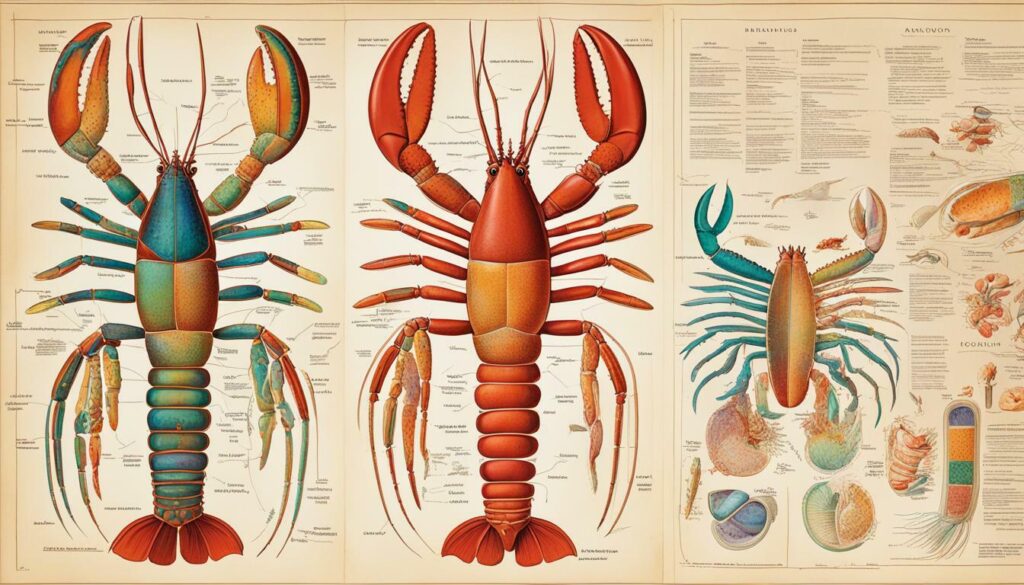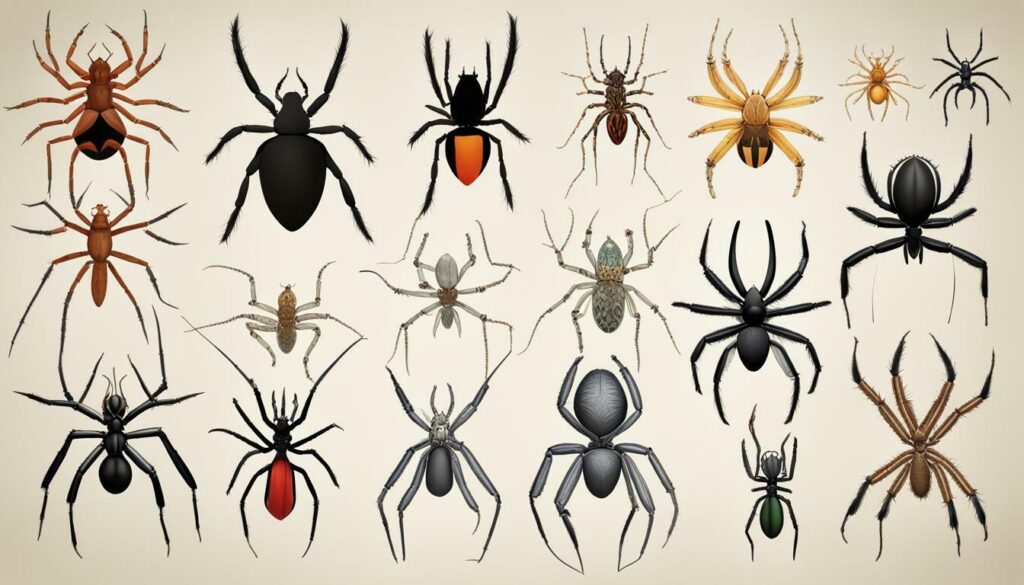When it comes to the classification of lobsters, there is often confusion surrounding their relationship to arachnids. While lobsters may share some similarities with arachnids, they are not members of this group. Lobsters belong to the arthropod group and are classified as crustaceans.
Lobsters are one of the many species that fall under the arthropod umbrella, which includes insects, spiders, and crustaceans. While many people may think of arachnids as the most similar group to lobsters, it’s important to note that arachnids are a distinct and separate group from crustaceans like lobsters.
So what sets lobsters apart from arachnids? Let’s dive deeper into the anatomy and characteristics of both groups to gain a better understanding of their differences.
- Key Takeaways:
- Understanding Lobster Anatomy and Characteristics
- Lobster Anatomy
- Lobster Characteristics
- Exploring Arachnid Classification and Traits
- Lobster Evolution and Relationship to Arachnids
- Conclusion
- Appreciating the Unique Characteristics of Lobsters and Arachnids
- FAQ
- Q: Are lobsters considered arachnids?
- Q: What is the classification of lobsters?
- Q: How do lobsters differ from arachnids?
- Q: Are lobsters related to arachnids?
- Q: Can lobsters be considered part of the arachnid family?
Key Takeaways:
- Lobsters are not arachnids but rather crustaceans belonging to the arthropod group.
- Arthropods include insects, spiders, and crustaceans like lobsters.
- Understanding the classification and traits of both lobsters and arachnids can help us appreciate their unique characteristics.
Understanding Lobster Anatomy and Characteristics
Lobsters are fascinating creatures with a unique anatomy and set of characteristics that set them apart from other crustaceans, including arachnids. While lobsters share similarities with other species in the arthropod family, they have several distinct features that make them easily distinguishable.
Lobster Anatomy
One of the most notable aspects of the lobster anatomy is its hard shell, which acts as a protective exoskeleton. Lobsters have a segmented body consisting of a head, thorax, and abdomen. The head houses the lobster’s compound eyes, antennae, and mouthparts, while the thorax bears the walking legs and claws. The abdomen contains the tail fan and swimmerets, which are used for movement and reproduction.
Lobsters also have a unique circulatory system, known as an open circulatory system, where their blood flows through cavities and sinuses rather than enclosed vessels. Additionally, lobsters have a complex nervous system, including a brain and multiple ganglia, which allows them to sense and respond to their environment.
Lobster Characteristics
Beyond their anatomy, lobsters have several characteristics that make them stand out among other crustaceans. For example, they are known for their impressive size, with some individuals growing up to three feet long and weighing over 40 pounds.
Lobsters are also well-known for their ability to regenerate their limbs. If a lobster loses a claw or leg, it can regrow a new one over time. Additionally, lobsters have a complex social structure that includes dominance hierarchies and communication through chemical and visual cues.
“Lobsters have several characteristics that make them stand out among other crustaceans.”
Overall, understanding the anatomy and characteristics of lobsters is crucial in differentiating them from other species, including arachnids. By appreciating their unique qualities, we can further appreciate the fascinating world of crustacean species and their place in the animal kingdom.
Exploring Arachnid Classification and Traits
Arachnids are a diverse group of joint-legged creatures that includes spiders, scorpions, ticks, and mites. They are part of the phylum Arthropoda, which also encompasses crustaceans, insects, and other arthropods.
Arachnids are classified based on their body structure and traits. They have two main body parts: the cephalothorax (head and thorax fused together) and the abdomen. Unlike lobsters, which have antennae, arachnids have specialized sensory structures called pedipalps, which are used for a variety of functions such as hunting, mating, and defense.
One of the distinguishing traits of arachnids is their ability to produce venom. Spiders and scorpions are particularly well-known for their venomous bites and stings, which they use to subdue prey and defend themselves from predators.
Arachnids also have a unique respiratory system. Rather than breathing through their mouths or noses, they have book lungs or tracheae, which are specialized organs for gas exchange.
Arachnids are incredibly diverse, with over 100,000 known species. They inhabit a wide range of environments, from forests and deserts to oceans and freshwater habitats. While many people view arachnids as creepy or dangerous creatures, they play important roles in ecosystems as predators, decomposers, and pollinators.
Lobster Evolution and Relationship to Arachnids
Lobsters have been around for millions of years, undergoing significant evolutionary changes over time. In fact, the earliest known lobster fossil dates back to the Late Jurassic period, around 150 million years ago.
Despite their evolutionary history, lobsters are not closely related to arachnids. While they share certain anatomical features, such as jointed limbs and a hard exoskeleton, lobsters belong to the arthropod family, a larger group that encompasses a variety of crustaceans, insects, and arachnids.
However, there are some interesting similarities between lobsters and arachnids, particularly in terms of their behavior and habitat. Both lobsters and arachnids are primarily nocturnal creatures, seeking shelter in dark underwater crevices or hidden land burrows during the daytime. Additionally, both groups have adapted to their environment by developing strong claws or fangs for hunting and defense.
Despite these similarities, lobsters and arachnids have distinct evolutionary paths. Lobsters are believed to have evolved from a common ancestor of shrimp and crabs, while arachnids evolved from a different branch of the arthropod family tree. Furthermore, lobsters have a more complex nervous system and a more diverse range of behaviors than arachnids, suggesting a greater degree of evolutionary advancement.
In conclusion, while lobsters and arachnids share some similarities, they are fundamentally different creatures. Lobsters belong to the arthropod family and have a unique evolutionary history that sets them apart from arachnids. By understanding the evolutionary relationship between these two groups, we can gain a deeper appreciation for the diversity and complexity of the animal kingdom.
Conclusion
After examining the question “are lobsters arachnids?” in detail, we have come to the conclusion that lobsters are not arachnids. Instead, they belong to the arthropod group, specifically the crustacean family. While they share some similarities with arachnids, such as jointed appendages, lobsters have distinct anatomical and evolutionary differences.
Appreciating the Unique Characteristics of Lobsters and Arachnids
By understanding the classification and traits of both lobsters and arachnids, we can appreciate the unique characteristics of each group. Lobsters have a hard exoskeleton and claws for grasping food, while arachnids have eight legs and usually have venomous fangs. Both groups have evolved over time, developing adaptations to help them survive and thrive in their respective environments.
Overall, while lobsters may not be arachnids, they are still fascinating creatures with many interesting characteristics worth exploring. By gaining a deeper understanding of their classification and traits, we can better appreciate the diversity and complexity of the animal kingdom.
FAQ
Q: Are lobsters considered arachnids?
A: No, lobsters are not considered arachnids. They are a type of crustacean belonging to the arthropod group.
Q: What is the classification of lobsters?
A: Lobsters are classified as crustaceans, specifically decapods, which are characterized by their ten legs and hard exoskeleton.
Q: How do lobsters differ from arachnids?
A: Lobsters have distinct anatomical and evolutionary differences compared to arachnids. While they both belong to the larger group of arthropods, lobsters have more legs and different body structures.
Q: Are lobsters related to arachnids?
A: Lobsters and arachnids do not share a close evolutionary relationship. They have different ancestry and have evolved separately within the larger arthropod group.
Q: Can lobsters be considered part of the arachnid family?
A: No, lobsters cannot be considered part of the arachnid family. They have their own unique classification as crustaceans within the arthropod group.












